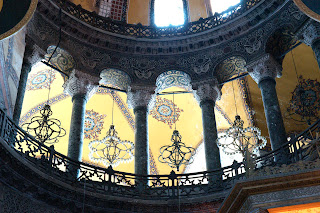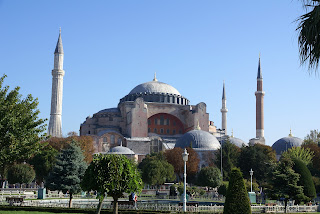The above photo shows the upper gallery decor above the Empress' Loge. The upper gallery is reached by means of a long ramp, shown in the photos below. The Ramp starts in the narthex in the orthwest corner of the building.
The first photo below is taken from the upper gallery above the Emperor's entrance looking towards the apse. The second is from the upper gallery, apse end, looking towards the Emperor's entrance.
The three photos above show typical decor of the gallery ceiling, columns and window arches.The photo below shows where some of the Muslim plaster has been removed revealing the original Byzantine beneath. When the Muslims took over in the 15th century they redecorated, including plastering over the mosaics. Their belief does not like depictions of humans but does allow for geometric designs.
The above is a partial bit of a painting or mosaic from an arch in the upper gallery.
This mosaic of Mary with the Christ child is high up in the apse. It has been dated to the 9th century. Below is more of a closeup; at least as close as I could get from the upper gallery.
The mosaics that have been uncovered are quite amazing. The two photos below show what are called the Empress Zoe mosaics. They show Constantine IX, his Empress, Zoe, and Chris or Christ and Mary. They date from the 11th century.
This next mosaic is one of my favorites, even though it is only partially intact. It is referred to as the Deesis mosaic. In the early 1200s the Venetians sacked Constantinople and it was returned to Byzantine control 57 years later. This mosaic was done in 1261 in commemoration of the return to Byzantine control. It shows Mary and John the Baptist with Christ. I find Christ's eyes remarkable; they seem to bore right through me.
The above mosaic, found on the tympanum of one of the exit doors from the nave to the narthex, is another favorite. It shows the Emperor Justinian on the left presenting a model of the Hagia Sophia to Mary and the Christ child. On the right the Emperor Constantine presents a model of the city of Constantinople. This mosaic dates from the 9th or 10th century.
This is a part of the original frieze, depicting the Lamb of God.
A note on the photos--all the photos in this and the previous blog entry were taken with a Sony a900 DSLR and a Zeiss 24-70mm lens. Because of the difficulty of using a tripod here, they were all hand held. The interior shots were mostly if not all shot at ISO 2500, to get the aperture I wanted and have a fast enough shutter speed to prevent blurring.




















































